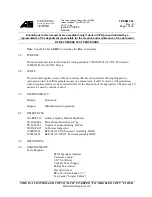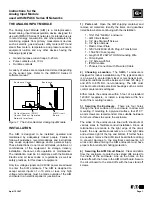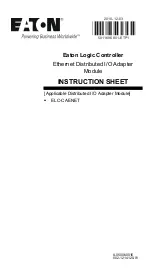
Manual DINAMO Plug & Play
Control your miniature world
Page 12 of 32
Version 1.2 – Dec 21
st
, 2017
2017 Leon van Perlo
3.3
Mounting
The TM44 is intended to be placed behind or underneath the miniature world. Preferably the
TM44 is mounted close to the tracks it supplies power to. It is recommended to limit the
cable length between TM44 and tracks to 10 meter. For practical reasons, multiple TM44’s
can be mounted close together, if this does not result in long leads to the tracks.
The TM44 (bare unit) has 4 mounting holes (3mm). Preferably use spacers (approximately 10
mm) when mounting the TM44, so that the back of the TM44 does not get into contact
with the mounting panel. This is especially important when you mount the TM44 on a metal
surface! When mounting the TM44 on a metal surface, keep especially in mind that the
mounting holes are connected to 0V/GND and that the metal mounting surface will carry the
same potential in this case.
The TM44’s (as bare unit) are ”stackable” by using M3 x 30mm spacers between the
modules. When mounting the modules, make sure to allow for enough space to insert the
connectors including cables and make sure you can still access the dipswitches at the side.
Fig 11: Stacking multiple TM44’s
If you have the TM44 in enclosure, simply mount the TM44 using the 4 screws that come
with the unit or enclosure to a suitable flat surface. As with the bare unit, make sure to
allow for enough space to insert the connectors including cables and make sure you can still
access the dipswitches at the side.
3.4
Connect Power Supply to the TM44
The TM44 shall be powered by a
DC power
only!
Power supply is delivered to the TM44 through connector K1. This connector has 4 term-
inals, from which P&P only uses Pin 1 and 2. So
do not connect pin 3 and 4!
(see figure 13)
1.
PWR:
+12..20 Volt DC
This terminal is meant for the running power (Vrs) = power for your trains.
2.
GND
: Ground, Earth, 0V or reference-potential, in other words, the ‘minus’ pole of the
power supply/supplies
Control your miniature world
Manual DINAMO Plug & Play
2017 Leon van Perlo
Version 1.2 – Dec 21
st
, 2017
Page 21 of 32
S7 & S8 OFF
USB
S7 & S8 OFF
Terminators OFF
KEEP SHORT!
RJ45 cable
R
J
4
5
c
a
b
le
T
M
4
4
T
M
4
4
O
C
3
2
/N
G
O
C
3
2
/N
G
RM-C/1+
Terminators OFF
O
C
3
2
/N
G
S7 & S8 OFF
T
M
4
4
Terminators
ON
O
C
3
2
/N
G
Fig 22: Another Dinamo P&P network example
activated.
All other modules shall have their terminator de-activated.
If you don’t comply
with this rule, the good news is that your network will still work (in most cases). However,
the bad news is that communication may be instable, or at some point become instable,
causing vague problems in your system.
The terminators on your TM44 modules are activated by dipswitches you find at the side of
the unit (fig 24). S7 and S8 determine whether the terminator is active:
•
S7 & S8 = OFF: Terminator NOT active
•
S7 & S8 = ON: Terminator Active
Always put both switches in either the ON or
OFF position
The terminators on the OC32/NG module are
activated by jumpers. If you have an OC32/NG
with enclosure you need to open the case. This
can be done very easily. For instructions, if you
need them, please consult the OC32/NG manual.
The location of the OC32/NG termination jumpers
is depicted in figure 16 and a detail is shown in
fig 23. To activate the terminator, place
both
jumpers as indicated in fig 23. Pay attention that
Fig 23: Terminator location on the OC32/NG


































